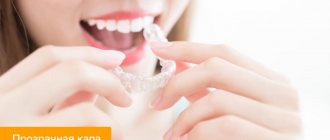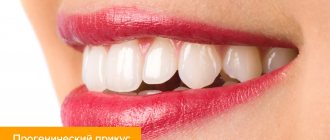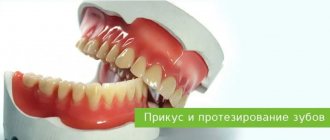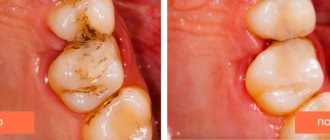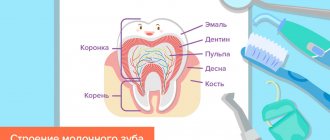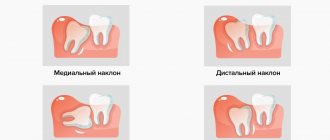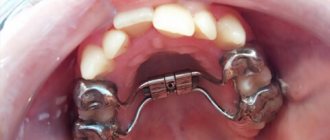Features of the dental structure - trainer
The main function of trainers is to correct the bite.
They are made of silicone material and look like a boxing mouth guard. The process of removing and installing the trainer does not cause discomfort; for these procedures there is no need to visit the dentist's office. The work of trainers is to change the activity of chewing mechanisms. They help not only to change the bite, but also to eliminate the cause of the incorrect position of the teeth. Many specialists can offer similar designs to improve nasal breathing, normal swallowing function, clear pronunciation of words, etc. This happens thanks to a device that affects the muscles, and they begin to work fully. It is much easier to influence the nature of the bite and the growth of teeth in childhood, which is when doctors recommend the use of trainers. However, adults can also apply this treatment; after a short amount of time, the problem with the aesthetic defect will be solved.
Bottom line
Problems with bite and other dental defects affect every second person in the modern world. Natural deficiencies in the anatomical structure of the jaw, injuries and bad habits can be corrected with the help of orthodontics. Plates and braces have been replaced by special dental trainers - orthodontic trainers, which effectively correct underdeveloped facial skeletons and other jaw pathologies. The affordable price, trouble-free operation of the trainers and easy care allow every adult and child to solve problems with dental pathologies.
The absence of metal parts and the elasticity of the material are a huge advantage of trainers over other orthodontic systems. The principle of operation of the simulators is not aimed at eliminating symptoms, but at eliminating the causes of pathological development of the jaw. This is an innovative development that prevents relapses during dental correction. Now you can correct not only your smile line, but also get rid of bad habits, overcome snoring and correct abnormal mouth breathing.
Sources used:
- Manufacturer's official website
- Vanarsdall,RL and White,RPJr. — Replais & Retencion: Professional and public attitudes, Am.J.Orthod. 98:184, 1990
- — Principles of retention in orthodontia
Who is recommended to wear trainers?
Indications for the use of trainers are:
- inadmissibility of correction using braces;
- fixing the positive effect after removing braces;
- minimal bite defects of the anterior incisors;
- elimination of bad habits that predispose to malocclusion;
- impaired nasal breathing or proper swallowing;
- eliminating problems with the speech apparatus.
It is advisable to use trainers at the stage of mixed or primary occlusion, as well as after completion of treatment with aligners or braces. In this case, the periodicity of the consolidation course corresponds to the terms of the previously completed orthodontic treatment. The low cost of trainer designs allows them to be used in complex occlusion correction of patients.
Bite defects in children
Children and teenagers often develop malocclusion, which is caused by incorrect positioning of the tongue and lips. If the baby is raised on artificial nutrition or has used a pacifier for too long, a malocclusion is guaranteed. Incorrect position of the lips and tongue is caused by the habit of putting the thumb in the mouth during sleep or during the day, and the habit of pulling various objects into the mouth.
Parents must promptly recognize the onset of malocclusion in order to take timely measures. Signs of developing pathology are:
- irregular face oval;
- separation of teeth in different parts of the jaw;
- parted lips;
- protruding tongue forward when swallowing;
- pathologies of teething;
- grimaces.
An irregular oval of the face can be noticed immediately: the face takes on an elongated shape or the lower part looks shortened. In profile, the head looks convex or concave. Often a child develops asymmetry: one part of the face visually looks larger than the other. The cause of the deformation may be a jaw that is too small or too large, or an abnormal inclination of the teeth.
How to determine the separation of teeth in a child? You need to ask the baby to close his teeth. With a properly formed bite, the upper teeth slightly cover the lower ones. If the upper teeth protrude forward (more than 1/3 of the length), this indicates pathology. The causes of this pathology can be bad habits: the position of the tongue between the upper and lower teeth, the inability to breathe through the nose, or prolonged pacifier/thumb sucking.
Parted lips are easy to notice - the baby constantly walks with his mouth open. If you ask a child to close his mouth, muscle tension can be seen. The cause of this pathology is mouth breathing or loose teeth.
When pushing the tongue forward during swallowing, the child constantly rests the tip of the tongue on the lips instead of the front teeth. This pathology is a consequence of the infantile type of swallowing inherent in infants. If the pathology is not corrected, multiple orthodontic problems may subsequently develop.
Grimaces on a child’s face appear when the facial muscles are overly tense. Characteristic folds appear on the cheeks and near the lips, and the chin becomes tense.
Pathologies of teething can be due to improper feeding (only liquid and pureed foods are on the menu) or due to injury to the jaw. The child may not have teeth for a long time, or the molars may begin to grow in the wrong position.
Types of dental trainers
Trainer systems today have several varieties. They are differentiated by different distinctive features, but most orthodontists choose to classify them according to the age category of the patients, although there are other parameters.
- for children under 10 years old - T4K. Children's trainers consist of two designs, intended for initial and final use. The size is intended for a small jaw with baby teeth. Parents are required to monitor the correctness and duration of wearing. When installing the trainer and wearing it, the child does not experience discomfort; it can be used even if there is difficulty breathing due to a runny nose or nasal congestion. Mainly for these purposes, there are small ventilation perforations on the mechanism. For the first eight months, the child should wear blue products, and then pink. The total duration of treatment can be a year or more, and the result obtained is no different from the effect after wearing braces.
- for teenagers – T4A. The shape and size of the trainers is suitable for the jaw of a 10-12 year old child. They are used to correct crooked teeth, correct malocclusion, and also as a fixative for results after wearing braces. With the help of trainers, you can adjust the jaw and facial muscles, which will allow them to function correctly. At the initial stage, blue products should be worn; for final correction, a red, more rigid design is used.
- for adults - T4B . Trainers for straightening teeth in adults must cope with a more complex task - correcting teeth on an already formed jaw. They are rarely installed; in most cases they are attached on top of the bracket system at night. The product is multifunctional and suitable for almost all patients. To achieve a positive result, you need to wear T4B trainers at least twelve hours a day, eating and talking is prohibited.
Corrective therapy algorithm
The therapy process is conventionally divided into 2 stages:
- 1 half of the course lasts about six months (the period may vary depending on the severity of the pathology). During this time, the patient uses trainers made of soft polymer. This allows the child to get used to the treatment process and adapt to the physical pressure on the teeth;
- Stage 2 involves wearing more rigid structures. With their help, the correction process is completed and the result is consolidated. Duration – from 1 to 1.5 years, in more complex cases, at the discretion of the doctor.
Note: if the doctor determines a mild form of the dental defect, then the course may be shorter. In this case, devices made of hard polymer are immediately used.
Pros and cons of treatment with trainers
Trainers have a sufficient number of advantages that distinguish them from other mechanisms that restore correct bite. These include:
- Fairly low cost construction. One trainer costs 3-4 times less than the cheapest brace system.
- Easy maintenance of the structure . The patient does not need to purchase additional cleaning products and devices, as is necessary when wearing braces.
- Individual approach to treatment . To create a mouth guard, you do not need to take an impression and wait for it to be made; it is already sold in the required shape and size.
- No psychological discomfort. The trainer can be removed at any time before an important conversation or meeting.
- Correction of the speech apparatus . It has long been proven that a trainer helps get rid of diction problems if they were associated with an incorrect bite.
- No trauma or additional stress on the hard and soft tissues of the teeth.
The disadvantages of trainers are related to the individual characteristics of wearing:
- Long lasting result. The effect may only appear a year after installation of the product.
- Constant monitoring by parents of compliance with high-quality wearing of trainers by children and adolescents.
- Inability to consume food and drinks while wearing trainers.
What effect does it have?
Each design feature in the trainer performs one or more functions in order to achieve one result - straightening teeth that are growing incorrectly.
- Channels-recesses - they guide the teeth from the moment they erupt.
- Labial arches - these mechanisms put pressure on incisors that grow unevenly. They limit the impact of soft tissue on the teeth, reducing their intensity.
- The tongue on the inside of the trainer is small in size, but performs important functions: it helps the tongue take a physiologically correct position (palatal), separates crowded teeth, and normalizes the development of the upper jaw.
- Tongue stopper – prevents the tongue from resting between the teeth.
- “Lip bumpers” - eliminate the child’s habit of biting his lips, which leads to soft tissue pressure on the teeth. In this case, there is a displacement of the teeth or their crowding in one place.
- Silicone tubercles - located on the outer surface of the device, affect the orbicularis oris muscle.
- The base of the device is wing-shaped - helps support the jaw near the temporomandibular joint.
How to properly install and wear a trainer?
For proper installation and wearing of the structure, it is important to adhere to a special sequence of actions, which consists of steps repeated every day:
- Place the trainer in the oral cavity so that the central stop is turned towards the upper palate.
- Find the location in which the stopper will touch the tip of the tongue without causing discomfort or tension.
- Gently jerk your lower jaw to the left and right until the plates are seated on the molars and stop sliding.
- Squeeze your jaw with little force until you feel light pressure on the entire row of teeth.
- Tighten your lips and try to take 3-4 deep breaths through your nose. If breathing is difficult, repeat steps 1 to 4 until breathing becomes completely easy.
- Take the time recommended by your doctor, do not unclench your lips, and under no circumstances try to start talking during the process.
- Remove the trainer from your mouth and rinse it under warm running water.
Application
To increase the effectiveness of eliminating orthodontic pathologies, it is important that the child independently learns how to put on and remove the MRC trainer. The first time it is better to do this under the supervision of an adult. The child needs to unpack the mouthguard, install it on the teeth, close the lips and jaw several times to firmly fix the trainer. After this, you need to take a few breaths through your nose.
When it comes to caring for your trainer, it is important to follow several rules:
- rinse it with warm water after removal;
- dry the mouth guard in a special container;
- Periodically clean the trainer with a brush and toothpaste.
If you notice cracks or other defects appearing on the surface of the mouth guard, consult a doctor.
Duration of teeth correction using trainers
Since the trainers are quite large, they are installed only at night and for a few hours during the day. The patient may feel a feeling of pressure and a little pain during the first time wearing the structure.
Mouthguards work and properly correct teeth only when worn constantly; noticeable results appear after 6-12 months.
Even with regular use of the trainer, after it there may be a need for additional orthodontic treatment using braces or aligners. This is determined by the complexity of the clinical case.
If a child cannot wear a trainer regularly, orthodontists recommend using permanent partial braces. They will function in the oral cavity 24 hours a day and will definitely give an effective result.
In the final period of orthodontic treatment, the trainer is also used at night and ends use according to the treatment plan.
For whom is it intended?
T4K trainers are designed for a specific group of patients. These are children from 5 to 12 years old.
Such designs are prescribed if :
- the child was diagnosed with a connection of teeth in one place where the lower jaw incisors grow;
- with deep bite;
- if the child has an open bite in the central area;
- Engel class I, II and mildly manifested III;
- incorrect position of the lower jaw;
- bad habits of the child (difficulty breathing, sucking foreign objects, improper swallowing), as well as difficulties in pronouncing words and letters;
- The lower jaw is positioned incorrectly and unnaturally.
Trainer care rules
The operational life of the device and the health of the patient’s oral cavity depend on proper cleaning of the trainer after each use.
Fortunately, trainers are convenient and practical to care for, unlike fixed dental structures. They are simply removed and washed with running water without the use of additional products. But the characteristics of the material require following certain rules when cleaning the trainer:
- Do not rinse the trainer with water of too high or too low a temperature, this may cause deformation of the silicone or polyurethane, and the product will lose its shape and, consequently, its functionality.
- There is no need to rub the trainer vigorously with hard objects, scratch it or stretch it. Otherwise, the trainer will not work effectively and properly influence the dental units.
- Sometimes there is a need to clean the trainer using soap or toothpaste, since running water does not always effectively remove all contaminants; bacteria that cause caries multiply on them.
- Trainers should be stored in a special plastic container so that it does not become damaged or dirty while not in use.
If cracks or other deformations appear on the product, it is necessary to immediately notify the attending orthodontist, since the structure may lose its functional properties, and pathogenic microorganisms may accumulate in the damage.
Timely installation of trainers will prevent further deformation changes in the human jaw.
Terms of use
Despite the elasticity of the material, exercise equipment can be damaged. The main damage is cracks or broken wires. In this case, you should immediately go to the orthodontist to replace the trainer. To prevent damage to the product, you should follow the operating rules:
- put on the exercise machine strictly according to the instructions;
- do not chew or talk with the splint in your mouth;
- Do not use ice-cold or very hot water to clean the machine;
- The trainer must be cleaned immediately after removal;
- the structure must be stored in a separate box;
- Do not throw the exercise machine or drop it on the floor.
Remember that a damaged trainer loses its properties and is not useful. Inspect the structure daily for damage in order to notice defects in time.
There is a so-called 2x4 braces system
The idea is that the child is given braces on four permanent incisors (these are the front teeth) and two large molars. That is, it turns out that we can only use this system in children, starting from the age of seven or eight, when the incisors have already erupted.
What are the advantages of braces in young children when correcting their bite?
- The first advantage
is that with such a system (2x4) the effect occurs quite quickly, because it uses the mechanics and power of braces, which, in fact, move the teeth. - The second advantage
is that the braces are not removable, and therefore the child simply does not have the opportunity to take them off, say, during a visit to school, and put them back on. But this is also a minus of braces. About this - below
The global problem and disadvantage that lies in braces is that they are non-removable, which means that:
- firstly
, they contribute to the accumulation of plaque, and children do not always have the opportunity to brush their teeth properly, especially in school settings. This causes some discomfort. - secondly
, braces also impose restrictions on the intake of hard foods. That is, food must be crushed. Either chop it into pieces, or it should have a soft consistency. - and thirdly
, of course, this is what I already said, difficulties in oral hygiene, which means that the risk of developing caries, gum inflammation and everything that we consider as complications from improper oral hygiene increases.
If we consider all these devices in terms of the speed of occurrence and development of the effect, then, of course, the last technique - braces
- is the most effective. Again, I repeat, because it uses the power of the mechanics of the brace system.



